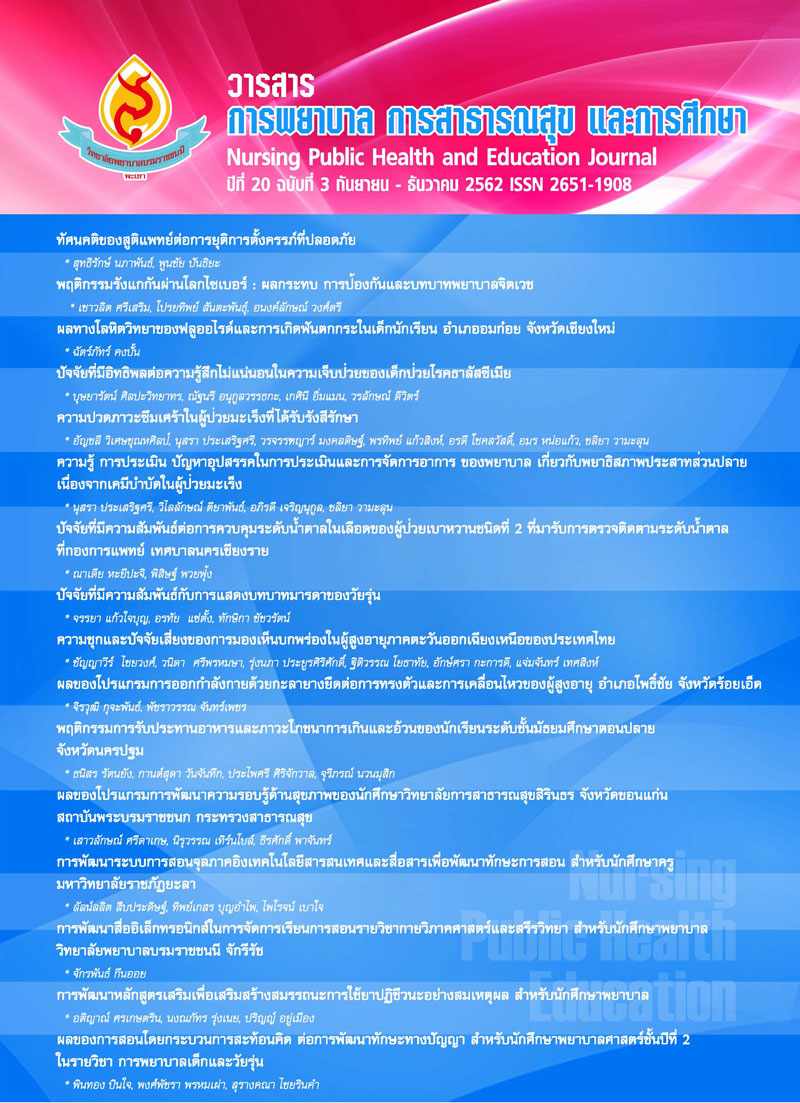ผลทางโลหิตวิทยาของฟลูออไรด์และการเกิดฟันตกกระ ในเด็กนักเรียน อำเภออมก๋อย จังหวัดเชียงใหม่
คำสำคัญ:
ผลทางโลหิตวิทยา โลหิตจาง, ความสมบูรณ์ของเลือด, ฟลูออไรด์, ฟันตกกระ, Haematology, Haematological effect, Anaemia, Complete Blood Count, Fluoride, Dental Fluorosisบทคัดย่อ
การศึกษาย้อนหลังแบบมีกลุ่มเปรียบเทียบนี้เพื่อศึกษาความผิดปกติของเลือดจากผลการตรวจวัดค่าความสมบูรณ์ของเม็ดเลือด (CBC) และประมาณค่าความเสี่ยงของความผิดปกติของเลือดและความเสี่ยงของการเกิดฟันตกกระ ในเด็กนักเรียนพื้นที่ฟลูออไรด์สูงและพื้นที่ฟลูออไรด์ต่ำจำนวน 301 คน ซึ่งอาศัยอยู่ในพื้นที่ ฟลูออไรด์สูง ร้อยละ 38.87 และพื้นที่ฟลูออไรด์ต่ำ ร้อยละ 61.13 เครื่องมือที่ใช้ในการวิจัย ประกอบด้วย แบบสอบถามข้อมูลทั่วไป แบบสอบถามเกี่ยวกับแหล่งน้ำบริโภคชุดเครื่องตรวจวัดระดับฟลูออไรด์ในเลือดและปัสสาวะ แบบบันทึกข้อมูลผลการตรวจวัดปริมาณฟลูออไรด์ในเลือดและผลการตรวจวัดความสมบูรณ์ของเม็ดเลือดและแบบบันทึกผลการตรวจสภาวะฟันตกกระในเด็กนักเรียนสถิติที่ใช้ประกอบด้วย ความถี่ ร้อยละ ค่าเฉลี่ย มัธยฐาน ส่วนเบี่ยงเบนมาตรฐานIndependent t-testสัมประสิทธิ์สหสัมพันธ์ของสเปียร์แมน (Spearman) Chi-square และวิเคราะห์การถดถอยโลจิสติกผลการวิจัยพบว่ากลุ่มตัวอย่างในพื้นที่ฟลูออไรด์สูงมีค่าเฉลี่ยฟลูออไรด์ในเลือด 0.093 mg/L พื้นที่ฟลูออไรด์ต่ำ มีค่าเฉลี่ยฟลูออไรด์ในเลือด 0.047 mg/L ค่าอ้างอิงในประชากรปกติ เท่ากับ 0.043 mg/L กลุ่มตัวอย่างในพื้นที่ฟลูออไรด์สูงมีค่า Haematocrit (Hct), Mean cell volume (MCV), Mean cell hemoglobin concentration (MCHC) และค่า Platelets (Plt) แตกต่างกันกับพื้นที่ฟลูออไรด์ต่ำอย่างมีนัยสำคัญทางสถิติ ส่วนกลุ่มตัวอย่างที่พบความผิดปกติของผลเลือดมีค่า Haematocrit (Hct), Mean cell volume (MCV) และMean cell hemoglobin concentration (MCHC) แตกต่างกับกลุ่มตัวอย่างที่ไม่พบความผิดปกติของผลเลือดอย่างมีนัยสำคัญทางสถิติ และเมื่อฟลูออไรด์ในเลือด >0.043mg/Lพบความผิดปกติของค่าฮีโมโกลบิล (Hb)(OR = 2.138, 95% CI = 1.106-4.133), ค่าฮีมาโตคริต (Hct) (OR = 3.124, 95% CI = 1.828-5.341), ค่าความเข้มข้นเฉลี่ยของฮีโมโกลบินในเม็ดเลือดแดง(MCHC)(OR = 2.223, 95% CI = 1.434-3.479)และค่าเกล็ดเลือด(Plt)(OR = 1.92, 95% CI = 0.298-0.909) ในพื้นที่ฟลูออไรด์สูงมีความชุกของฟันตกกระร้อยละ44.5 ส่วนพื้นที่ฟลูออไรด์ต่ำมีความชุกของฟันตกกระร้อยละ 29.9 กลุ่มตัวอย่างที่พบความผิดปกติของผลเลือดมีความชุกของฟันตกกระร้อยละ69.3 โอกาสของการเกิดฟันตกกระมีความสัมพันธ์กับปริมาณฟลูออไรด์ในเลือดที่เกินค่าเฉลี่ยอ้างอิง(0.043 mg/L)(OR = 1.771, 95%CI = 1.111-2.834) อย่างมีนัยสำคัญทางสถิติ ผลการศึกษาแสดงให้เห็นว่าค่าฟลูออไรด์ในเลือดและผล CBC สามารถใช้เป็นตัวบ่งชี้และเกณฑ์ในการคัดกรองความผิดปกติรวมทั้งประเมินความเสี่ยงจากการได้รับฟลูออไรด์เข้าสู่ร่างกายได้ค่าเฉลี่ยฟลูออไรด์ในเลือดที่ประมาณได้
HaematologicalEffects of Fluoride and Dental Flurosis Occurrence Among School Children in Omkoi District, Chiang Mai
The objective of this research was to study the hematological effects of fluoride and occurrence of dental fluorosis among School Children in Omkoi District, Chiang Mai. This research was proceed in 301 school children in both high level and low level fluoride contaminated area in Omkoi district, Chiang Mai Province. Research Instruments were data recording forms to collected general information, water consumption behavior, laboratory results in serum fluoride and complete blood count (CBC). Statistic analyses used in this study were frequency, percentage, mean, median, mode, standard deviation, Independent t-test, Spearman Correiation, Chi-square, Logistic Regression Analysis and Generalizes Least Square. The results shown that school children in high fluoride area have mean serum fluoride 0.093 mg/L while school children in low fluoride are have mean serum fluoride 0.047 mg/L (Reference of mean serum fluoride = 0.043 mg/L). There was a significantly difference of Haematocrit (Hct), Mean cell volume (MCV), Mean cell hemoglobin concentration (MCHC) and Platelets (Plt) among school children in high and low fluoride area. This was similar to school children that mean serum fluoride > 0.043 mg/L and school children that mean serum fluoride ≤ 0.043 mg/L that Haematocrit (Hct), Mean cell volume (MCV) and Mean cell hemoglobin concentration (MCHC) were significantly different. Most common haematological disorder that were found when Fserum>0.043 mg/L were Hb (OR = 2.138, 95% CI = 1.106-4.133), Hc (OR = 3.124, 95% CI = 1.828-5.341), MCHC (OR = 2.223, 95% CI = 1.434-3.479) and Plt (OR = 1.92, 95% CI = 0.298-0.909). The prevalence of dental fluorosis in high fluoride area was 44.5%. The prevalence of dental flurosis in haematological disorders group was 69.3%. The prevalence of dental fluorosis in high serum fluoride (> 0.043 mg/L) group was 67.3%. There was a significantly relationship between exceed serum fluoride and dental fluorosis (OR = 1.771, 95%CI = 1.111-2.834). Serum fluoride and CBC parameters can be used as indicators for screening of fluoride haematological disorders from fluoride.
เอกสารอ้างอิง
โรงพิมพ์คลังนานา; 2543.
2. ประกาศกระทรวงสาธารณสุข(2553).น้ำบริโภคในภาชนะบรรจุที่ปิดสนิท (ฉบับที่ 6)
ลงวันที่ 23 เมษายน 2553. ราชกิจจานุเบกษา เล่ม 127 ตอนพิเศษ 67 ง. ลงวันที่ 27
พฤษภาคม 2553.
3. ฟ้าใส คันธวงค์, เพ็ญพิชชา วนจันทรรักษ์, สุพจน์ ชำนาญไพร และฉัตรภัทร คงปั้น.
(2557). การตรวจวัดระดับฟลูออไรด์ในซีรัมของเด็กนักเรียน ตำบลยางเปา อำภอ
อมก๋อย จังหวัดเชียงใหม่. วารสารเทคนิคการแพทย์ เชียงใหม่, 47(3), 185-191.
4. Aoba, T., & Fejerskov,O. (2002). Dental fluorosis : chemistry and biology.
Dent Cosmos, 13(2), 155-170.
5. Adler, Péter & World Health Organization. Fluorides and human health / contributor.
(1970). Retrieved May 24, 2016, from
: https://apps.who.int/iris/handle/10665/41784
6. DenBesten, PK. (1999). Biological mechanisms of dental fluorosis relevant to the use of
fluoride supplements. Community Dent Oral Epidemiol, 27(1), 41-47.
7. Ekstrand, J., Ehrnebo, M., & Boréus L.O. (1978). Fluoride bioavailability after
intravenous and oral administration: importance of renal clearance and urine flow.
Clin Pharmacol Ther, 23(3), 329-337.
8. Ekstrand. J., Ziegler, E.E., Nelson, S.E.,& Fomon SJ. (1994).
Absorption and retention of dietary and supplemental fluoride by infants.
Adv Dent Res, 8(2), 175-180.
9. John, J. (1976). Fluorides in Caries Prevention. J. N. Swallow Published,
DOI:10.1016/S0033-3506(76)80063-7
10. Liu, M., & Qian, C. (2008). Effect of endemic fluorosis on children's intelligence
development: a Meta analysis. Zhongguo Dang Dai Er Ke Za Zhi , 10(6), 723-725.
11. McDonagh, M.S., Whiting ,P.F.,Wilson, P.M., Sutton, A.J., Chestnutt. I., Cooper J…
& Kleijnen J. (2000). Systematic review of water fluoridation. BMJ, 321(7265),
855-859.
12. Nochimson, G. (2008). Toxicity, Fluoride. Retrieved Dec 28,2017, from
https://emedicine.medscape.com/article/814774-overview
13. Pornprasert, S., Wanachantararak, P., Kantawong, F., Chamnanprai, S., Kongpan, C.,
Pienthai, N.,…& Prasannarong, M. (2017). Excessive fluoride consumption
increases haematological alteration in subjects with iron deficiency, thalassaemia,
and glucose-6-phosphate dehydrogenase (G-6-PD) deficiency. Environ Geochem
Health,39(4), 751-758.
14. Torra, M., Rodamilans, M., Corbella, J. (1998). Serum and urine ionic fluoride: normal
range in a nonexposed population. Biol Trace Elem Res, 63(1), 67-71.
15. University Hospitals Birmingham. (2017). Fluoride (serum).
Retrieved August 28, 2018, from :
https://www.heftpathology.com/item/fluoride-serum.htm
16. World Health Organization. (2006). Fluoride in Drinking-water by J. Fawell, K. Bailey,
J. Chilton, E. Dahi, L. Fewtrell and Y. Magara. ISBN: 1900222965. Published by
IWA Publishing, London, UK.



